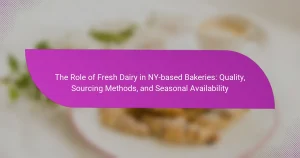Gluten-free ingredients are food components that lack gluten, a protein found in wheat, barley, and rye, and are essential for bakeries in New York catering to individuals with celiac disease and gluten intolerance. This article explores various gluten-free alternatives, such as almond flour, coconut flour, rice flour, and tapioca starch, highlighting their unique properties that contribute to texture and flavor in baked goods. It emphasizes the importance of implementing strict cross-contamination prevention measures, sourcing certified gluten-free products, and ensuring proper labeling for customer safety. Additionally, the article outlines best practices for staff training and regular audits to maintain high standards in gluten-free baking.

What are Gluten-Free Ingredients and Why are They Important for NY Bakeries?
Gluten-free ingredients are food components that do not contain gluten, a protein found in wheat, barley, and rye. These ingredients include alternatives like almond flour, coconut flour, rice flour, and tapioca starch. They are crucial for NY bakeries as they cater to the growing population of individuals with celiac disease and gluten intolerance. Approximately 1 in 100 people globally are affected by celiac disease, necessitating the availability of gluten-free options. Offering gluten-free products can expand a bakery’s customer base and enhance its reputation. Additionally, gluten-free ingredients often provide unique flavors and textures, appealing to a broader audience. Overall, incorporating gluten-free ingredients is essential for inclusivity and market competitiveness in the bakery industry.
How do Gluten-Free Ingredients differ from Traditional Ingredients?
Gluten-free ingredients differ from traditional ingredients primarily by the absence of gluten. Traditional ingredients, such as wheat flour, contain gluten, which provides elasticity and structure in baked goods. Gluten-free alternatives include almond flour, rice flour, and tapioca starch. These alternatives often require additional binding agents, like xanthan gum or guar gum, to mimic gluten’s properties. The texture and flavor profiles of gluten-free products can vary significantly compared to traditional baked goods. For instance, gluten-free breads may be denser and have a different crumb structure. Additionally, gluten-free ingredients often cater to specific dietary needs, such as celiac disease or gluten sensitivity. This distinction is crucial for bakers aiming to create products that meet diverse consumer preferences.
What are the most common gluten-free grains used in baking?
The most common gluten-free grains used in baking are almond flour, coconut flour, rice flour, and oat flour. Almond flour is made from ground almonds and provides moisture and flavor. Coconut flour is derived from dried coconut meat and is highly absorbent. Rice flour, both white and brown, is versatile and widely used in gluten-free recipes. Oat flour, made from ground oats, adds a mild flavor and texture. These grains are popular due to their ability to mimic the texture and taste of traditional wheat flour in baked goods.
How do gluten-free flours impact the texture and flavor of baked goods?
Gluten-free flours significantly affect the texture and flavor of baked goods. These flours often lack the gluten protein that provides elasticity and structure. As a result, baked goods may be denser and crumblier compared to those made with wheat flour. Common gluten-free flours include almond, coconut, and rice flour, each contributing unique flavors. For instance, almond flour adds a nutty taste, while coconut flour imparts a slight sweetness. The moisture absorption varies among gluten-free flours, impacting the overall moisture content of the final product. Adjustments in recipes are often necessary to achieve desired textures and flavors. Studies have shown that blending different gluten-free flours can improve the overall quality of baked goods.
What Health Benefits do Gluten-Free Ingredients Offer?
Gluten-free ingredients offer several health benefits, particularly for individuals with gluten intolerance or celiac disease. These ingredients are typically easier to digest for those sensitive to gluten. They can also reduce inflammation in the digestive tract. Gluten-free diets often lead to increased energy levels due to better nutrient absorption. Many gluten-free ingredients are rich in vitamins and minerals, such as quinoa and brown rice. Additionally, they can promote a healthier gut microbiome by including diverse fiber sources. Studies indicate that gluten-free diets can improve overall well-being for those with gluten sensitivity.
Who can benefit from a gluten-free diet?
Individuals with celiac disease can benefit from a gluten-free diet. Celiac disease is an autoimmune disorder triggered by gluten. Consuming gluten leads to damage in the small intestine for these individuals. People with non-celiac gluten sensitivity may also benefit. This condition causes symptoms similar to celiac disease but without intestinal damage. Additionally, individuals with wheat allergies should avoid gluten. A gluten-free diet helps alleviate their allergic reactions. Overall, those with gluten-related disorders significantly improve their health by eliminating gluten from their diet.
How do gluten-free ingredients support digestive health?
Gluten-free ingredients support digestive health by reducing inflammation and promoting gut healing. Many individuals with gluten sensitivity or celiac disease experience digestive discomfort when consuming gluten. Gluten-free grains like quinoa and brown rice are easier to digest and contain beneficial fibers. These fibers help maintain healthy gut bacteria, which is essential for digestion. Studies show that a gluten-free diet can improve symptoms in those with gluten-related disorders. For example, research published in the Journal of Gastroenterology found that patients reported significant relief from gastrointestinal symptoms after eliminating gluten. This indicates that gluten-free ingredients can play a crucial role in enhancing digestive health for sensitive individuals.

What Types of Gluten-Free Ingredients are Available for Bakeries?
Bakeries can use various gluten-free ingredients, including flours, starches, and binders. Common gluten-free flours include almond flour, coconut flour, and rice flour. These flours provide unique textures and flavors. Starches like tapioca starch and potato starch help improve the structure of baked goods. Binders such as xanthan gum and guar gum enhance the elasticity of gluten-free products. Each ingredient has specific properties that contribute to the final product’s quality. For example, almond flour adds moisture, while coconut flour absorbs liquid. Understanding these ingredients allows bakeries to create appealing gluten-free options.
What are the different categories of gluten-free ingredients?
The different categories of gluten-free ingredients include whole grains, flours, starches, and alternative ingredients. Whole grains such as quinoa, brown rice, and millet are naturally gluten-free. Gluten-free flours include almond flour, coconut flour, and chickpea flour. Starches like tapioca starch and potato starch serve as binding agents in recipes. Alternative ingredients can include nuts, seeds, and legumes, which provide additional nutrition. These categories help in creating gluten-free baked goods that meet dietary restrictions.
Which gluten-free flours are best for baking bread?
Almond flour, coconut flour, and brown rice flour are among the best gluten-free flours for baking bread. Almond flour provides moisture and a rich flavor. It contains healthy fats and protein, making it a nutritious choice. Coconut flour is highly absorbent and requires additional liquids in recipes. It adds a subtle sweetness to baked goods. Brown rice flour offers a neutral flavor and good texture. It is often used in combination with other gluten-free flours for better results. These flours are widely recommended by gluten-free baking experts. They are known for their ability to create bread with a desirable crumb and structure.
What are the top gluten-free sweeteners used in baking?
The top gluten-free sweeteners used in baking include honey, maple syrup, agave nectar, coconut sugar, and stevia. Honey is a natural sweetener that adds moisture and flavor. Maple syrup is derived from sap and provides a distinct taste. Agave nectar is sweeter than sugar and has a low glycemic index. Coconut sugar is made from the sap of coconut trees and retains some nutrients. Stevia is a plant-based sweetener that has no calories. These sweeteners are suitable for gluten-free baking and can enhance the flavor profile of baked goods.
How can NY Bakeries Source Quality Gluten-Free Ingredients?
NY bakeries can source quality gluten-free ingredients by establishing relationships with certified suppliers. These suppliers specialize in gluten-free products and ensure compliance with safety standards. Bakeries should prioritize suppliers who provide documentation of gluten-free certifications. Additionally, sourcing from local farms can enhance ingredient freshness and support the community. Researching online directories for gluten-free ingredient suppliers can also yield reliable options. Attending trade shows focused on gluten-free products can help bakeries discover new suppliers and trends. Collaborating with other local bakeries may lead to shared sourcing opportunities. Regularly reviewing ingredient labels for gluten content is essential for maintaining quality.
What should bakeries look for when selecting suppliers?
Bakeries should look for suppliers that offer high-quality, gluten-free ingredients. Quality is essential for maintaining product standards. Reliability in delivery schedules ensures consistent supply. Competitive pricing helps manage costs effectively. Suppliers should provide transparency about sourcing and production practices. Certifications for gluten-free status are crucial for compliance. Strong customer service supports problem resolution and communication. Positive reviews and referrals from other bakeries indicate supplier trustworthiness.
How can bakeries ensure the integrity of gluten-free ingredients?
Bakeries can ensure the integrity of gluten-free ingredients by implementing strict sourcing protocols. They should source ingredients from certified gluten-free suppliers. This guarantees that the products have been tested for gluten contamination. Bakeries must also establish separate storage areas for gluten-free ingredients. Cross-contamination can occur if gluten-containing products are stored nearby. Regular training for staff on gluten-free practices is essential. Staff should understand the importance of avoiding cross-contact. Additionally, bakeries can conduct regular audits of their suppliers. This helps to verify that the gluten-free status is maintained throughout the supply chain. Testing of finished products for gluten content can further ensure safety. Studies show that even trace amounts of gluten can affect individuals with celiac disease. By following these practices, bakeries can maintain the integrity of their gluten-free offerings.

What Best Practices Should NY Bakeries Follow When Using Gluten-Free Ingredients?
NY bakeries should follow strict cross-contamination prevention measures when using gluten-free ingredients. This includes using dedicated equipment and utensils for gluten-free baking. Bakeries must also ensure thorough cleaning of surfaces to remove gluten residues. Ingredient sourcing is critical; bakeries should choose certified gluten-free products. Proper labeling of gluten-free items is essential for customer safety. Staff training on gluten-free protocols enhances awareness and compliance. Regular audits of practices can help maintain standards. These practices are vital for ensuring the safety of customers with gluten sensitivities or celiac disease.
How can bakeries avoid cross-contamination with gluten?
Bakeries can avoid cross-contamination with gluten by implementing strict separation protocols. This includes designating specific areas for gluten-free preparation. Using separate utensils, equipment, and storage for gluten-free ingredients is essential. Staff should be trained on cross-contamination risks and safe practices. Regular cleaning of surfaces and tools is necessary to eliminate gluten residues. Labeling all gluten-free products clearly helps prevent accidental mixing. Monitoring ingredient sources ensures that they are certified gluten-free. These practices are critical for safeguarding customers with gluten sensitivities or celiac disease.
What are effective storage solutions for gluten-free ingredients?
Effective storage solutions for gluten-free ingredients include airtight containers, cool and dry storage locations, and labeling. Airtight containers prevent moisture and cross-contamination. A cool and dry environment helps maintain ingredient quality. Labeling ensures easy identification and prevents mix-ups. For example, storing gluten-free flours in glass jars preserves freshness. Using vacuum-sealed bags can extend shelf life by reducing air exposure. These methods are essential for maintaining the integrity of gluten-free ingredients.
What Tips Can Help Bakeries Successfully Implement Gluten-Free Baking?
Bakeries can successfully implement gluten-free baking by understanding ingredient substitutions and practicing cross-contamination prevention. Gluten-free flours, such as almond, coconut, or rice flour, should replace traditional wheat flour. Each flour type has unique properties affecting texture and flavor. For example, almond flour adds moisture while coconut flour absorbs more liquid.
Bakeries must also ensure separate equipment for gluten-free items to avoid cross-contamination. Dedicated utensils, mixers, and baking sheets should be used exclusively for gluten-free products. Staff training on gluten-free protocols is essential for maintaining safety and quality.
Testing recipes is crucial to achieve desired taste and texture. Many bakeries find success by blending different gluten-free flours for optimal results. Regular customer feedback can guide improvements and adaptations.
Finally, sourcing high-quality gluten-free ingredients from reliable suppliers enhances product consistency and customer satisfaction.
How can bakeries educate staff on gluten-free baking techniques?
Bakeries can educate staff on gluten-free baking techniques through structured training programs. These programs should include hands-on workshops that demonstrate specific gluten-free recipes and methods. Staff can benefit from learning about different gluten-free flours and their properties. Understanding cross-contamination is crucial for maintaining safety in gluten-free baking.
Utilizing online resources and courses can supplement in-person training. Bakeries can also invite gluten-free baking experts for guest lectures. Regularly updating training materials ensures staff stay informed about new techniques. Encouraging staff to experiment with gluten-free recipes fosters practical learning.
Research supports that comprehensive training improves staff confidence and product quality. A study published in the Journal of Culinary Science & Technology found that trained staff create better gluten-free products.
What are common challenges bakeries face when transitioning to gluten-free products?
Bakeries face several challenges when transitioning to gluten-free products. Sourcing gluten-free ingredients can be difficult due to availability and cost. Many gluten-free flours do not behave like wheat flour, affecting texture and taste. Cross-contamination with gluten-containing ingredients is a significant concern. Training staff on gluten-free baking techniques is often necessary. Consumer perception of gluten-free products can be a barrier to sales. Additionally, maintaining consistent quality can be challenging as recipes are adapted. These factors can complicate the transition process for bakeries.
Sourcing gluten-free ingredients is essential for NY bakeries to meet the needs of individuals with celiac disease and gluten intolerance. This article provides an overview of various gluten-free ingredients, including common flours and sweeteners, and their health benefits, such as improved digestion and increased energy levels. It also outlines best practices for avoiding cross-contamination, effective storage solutions, and training staff on gluten-free baking techniques, ensuring bakeries can successfully implement gluten-free offerings while maintaining quality and safety.




